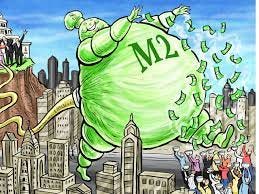I am not a macro-economist. In fact I am not any kind of economist. But I do follow macro-economic news, most notably Fed policy, which is important to understanding financial institutions and markets. And I attempt to understand at least the main points of the debate surrounding monetary policy and real economic activity, a debate which is again raging following more than a decade of unprecedented monetary expansion and the recent resurgence of inflation in the US and internationally.
If you studied macro-economics back in the 1970’s, as I did, you may have learned that inflation is caused by an excessive increase in the money supply, a thesis often attributed to Milton Friedman and summarized in bumper-sticker fashion as “printing money causes inflation”. Key to this argument was empirical data going back decades suggesting a strong relationship between changes in the money supply and the level of inflation. This economic argument developed strong political support in Washington during the 1980s, following the election of Ronald Reagan. Ironically, this was also a time when Fed Chair Paul Volcker was aggressively raising interest rates (not targeting the money supply per se) in a painful but successful effort to fight off rampant inflation kindled during the 1970s, the so-called decade of “stagflation”.
If you were really paying attention in your macro-economics class (which not all of us were), you may have had some follow-up questions about the definition of “money supply” used in the analysis, the strength of the historical correlation between the money supply and real economic activity, and the nature of any causal relationship between the two. You will have memorized for your exam various definitions of money supply—M0, M1, M2 and the now discarded M3—but you likely did not fully appreciate the significance of these seemingly arcane statistics. Nor did you anticipate how important this issue would become in the years and decades to follow.
I am a firm believer that it is never too late to learn—even at my advanced age—and that is what I attempt to do in my own small way with this newsletter. So today we are all going to learn a bit more about the relationship between the money supply and real economic activity, in the hopes that we can better understand the current monetary policy deliberations of the Fed and parse some of the related political “discourse”. In just the past two weeks, we have witnessed a Republican Congressman "explaining” to Fed Chair Powell the relationship between money supply and inflation (start watching the video at 53:35) and Democrats suggesting that inflation is caused by corporate greed. It seems that demonstrations of economic ignorance and bumper-sticker wisdom may be the only bipartisan thing happening in DC these days.
So in the interests of learning something from this teachable moment, let me pose a few questions for your consideration: What do we mean exactly when we talk about the Fed (or other central banks) “printing money”? What are the differences between the various definitions of “money” used by the Fed and other central banks to set monetary policy and why are these important? To what extent do central banks control or influence changes in the level of these various “monetary aggregates”? What is the role of financial institutions and other non-central bank actors in driving or transmitting changes in the level of the monetary aggregates and influencing subsequent changes in real economic activity? How does the changing turnover or velocity of money impact the money supply analysis? How is it possible that $10 trillion of monetary expansion (Quantitative Easing) by central banks globally over the past 14 years has not caused inflation? Conversely, if “printing money” always causes inflation, why did it take so long for QE to have this effect? [Note: QE began in most of the world in 2008, earlier in Japan, with another big round following the onset of covid in early 2020. Various measures of inflation have only started to rise significantly in recent months, however, and prices have not increased uniformly across all goods and services, in the US or elsewhere.]
As noted, I am not an economist and so I am not going to attempt to answer these questions for you. Rather I would ask that you reflect upon them for a few minutes on your own, particularly my question about the role of financial institutions. And then I would ask you to read this short piece written by Paul Krugman and published in The NY Times under the title “Money isn’t Everything” .
And if you have an extra 5” or so, I think you may enjoy watching on video the “questioning” of Fed chair Powell by Rep. Taylor of Texas, cited above and in Krugman’s article. Whatever you think of the Fed’s policy actions under Chair Powell, you have to be impressed with the concise, informed and respectful way in which Mr. Powell replied to Rep. Taylor’s polemics. The key substantive points made by Chair Powell are also summarized in this short piece published on the Fed website, What is the Money Supply? Is it Important?,
The debate surrounding Fed monetary policy is not going away any time soon, and neither is partisan politics, so stay tuned for more bumper sticker slogans and half-baked economic analysis in the run up to next year’s mid-term elections. The elections are only 11 months away, but I’ll bet it will seem a lot longer.
Links:
“Money isn’t Everything”, Krugman, NY Times 3 December 2021
Congressional Testimony of Chair Powell and Secretary Yellen, You Tube, 1 December 2021
“The Greediest Thanksgiving Ever”, Washington Post, 25 November 2021



Great article, my 2 cents; it’s the velocity of money that counts and explains why we didn’t have inflation prior to current supply chain problems despite 20 years of excessive money printing
Walter